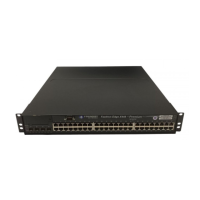SNMP version 3 also supports View-Based Access Control Mechanism (RFC 2575) to control access at
the PDU level. It defines mechanisms for determining whether or not access to a managed object in a
local MIB by a remote principal should be allowed. For more information, refer to SNMP v3
configuration examples on page 160.)
Configuring your NMS
In order to use the SNMP version 3 features.
1. Make sure that your Network Manager System (NMS) supports SNMP version 3.
2. Configure your NMS agent with the necessary users.
3. Configure the SNMP version 3 features in Brocade devices.
Configuring SNMP version 3 on Brocade devices
Follow the steps given below to configure SNMP version 3 on Brocade devices.
1. Enter an engine ID for the management module using the snmp-server engineid command if you
will not use the default engine ID.Refer to Defining the engine id on page 151.
2. Create views that will be assigned to SNMP user groups using the snmp-server view command.
refer to SNMP v3 configuration examples on page 160 for details.
3. Create ACL groups that will be assigned to SNMP user groups using the access-list command.
4. Create user groups using the snmp-server group command.Refer to Defining an SNMP group on
page 152.
5. Create user accounts and associate these accounts to user groups using the snmp-server user
command.Refer to Defining an SNMP user account on page 153.
If SNMP version 3 is not configured, then community strings by default are used to authenticate
access.
Defining the engine id
A default engine ID is generated during system start up. To determine what the default engine ID of the
device is, enter the show snmp engineid command and find the following line:
Local SNMP Engine ID: 800007c70300e05290ab60
See the section Displaying the Engine ID on page 159 for details.
The default engine ID guarantees the uniqueness of the engine ID for SNMP version 3. If you want to
change the default engine ID, enter the snmp-server engineid local command.
device(config)#snmp-server engineid local 800007c70300e05290ab60
Syntax: [no] snmp-server engineid local hex-string
The local parameter indicates that engine ID to be entered is the ID of this device, representing an
SNMP management entity.
NOTE
Each user localized key depends on the SNMP server engine ID, so all users need to be reconfigured
whenever the SNMP server engine ID changes.
Configuring your NMS
FastIron Ethernet Switch Administration Guide 151
53-1003625-01

